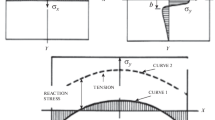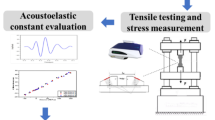Abstract
To address the difficulty in testing and calibrating the stress gradient in the depth direction of mechanical components, a new technology of nondestructive testing and characterization of the residual stress gradient field by ultrasonic method is proposed based on acoustoelasticity theory. By carrying out theoretical analysis, the sensitivity coefficients of different types of ultrasonic are obtained by taking the low carbon steel(12%C) as a research object. By fixing the interval distance between sending and receiving transducers, the mathematical expressions of the change of stress and the variation of time are established. To design one sending-one receiving and oblique incidence ultrasonic detection probes, according to Snell law, the critically refracted longitudinal wave (LCR wave) is excited at a certain depth of the fixed distance of the tested components. Then, the relationship between the depth of LCR wave detection and the center frequency of the probe in Q235 steel is obtained through experimental study. To detect the stress gradient in the depth direction, a stress gradient LCR wave detection model is established, through which the stress gradient formula is derived by the relationship between center frequency and detecting depth. A C-shaped stress specimen of Q235 steel is designed to conduct stress loading tests, and the stress is measured with the five group probes at different center frequencies. The accuracy of ultrasonic testing is verified by X-ray stress analyzer. The stress value of each specific depth is calculated using the stress gradient formula. Accordingly, the ultrasonic characterization of residual stress field is realized. Characterization results show that the stress gradient distribution is consistent with the simulation in ANSYS. The new technology can be widely applied in the detection of the residual stress gradient field caused by mechanical processing, such as welding and shot peening.
Similar content being viewed by others
References
LIU C, ZHUANG D. Internal welding residual stress measurement based on contour method[J]. Chinese Journal of Mechanical Engineering, 2012, 48(8): 54–59. (in Chinese)
TOTTEN G E, HOWES M, INOUE T. Handbook of residual stress and deformation of steel[M]. New York: ASM International Publishers, 2002.
CHAN K S, ENRIGHT M P, MOODY J P, et al. Residual stress profiles for mitigating fretting fatigue in gas turbine engine disks[J]. International Journal of Fatigue, 2010, 32: 815–823.
ZAROOG O S, ALI A, SAHARI B B, et al. Modeling of residual stress relaxation of fatigue in 2024-T351 aluminium alloy[J]. International Journal of Fatigue, 2011, 33: 279–285.
JACOMINO J L, BURGOS J S, CRUZ A C, et al. Use of explosives in the reduction of residual stresses in the heated zone of welded joints[J]. Welding International, 2010, 24(12): 920–925.
WITHERS P J, BHADESHIA H K. Residual stress Part 1––Measurement techniques[J]. Materials Science and Technology, 2001, 17: 355–365.
ROSSINI N S, DASSISTI M, BENYOUNIS K Y, et al. Methods of measuring residual stresses in components[J]. Materials and Design, 2012, 35: 572–588.
MIAO H, ZUO D W, WANG M, et al. Numerical calculation and experimental research on residual stresses in precipitationhardening layer of NAK80 steel for shot peening[J]. Chinese Journal of Mechanical Engineering, 2011, 24(3): 439–445.
WITHERS P J. Mapping residual and internal stress in materials by neutron diffraction[J]. Comptes Rendus Physique, 2007, 8(8): 806–820.
DESVAUS S, DUQUENNOY M, GUALANDRI J, et al. Evaluation of residual stress profiles using the Barkhausen noise effect to verify high performance aerospace bearings[J]. Nondestructive Testing and Evaluation, 2005, 20(1): 9–24.
JHANG K Y, QUAN H H, HA J, et al. Estimation of clamping force in high-tension bolts through ultrasonic velocity measurement[J]. Ultrasonics, 2006, 44: e1339–e1342.
SASAKI Y, HASEGAWA M. Effect of anisotropy on acoustoelastic birefringence in wood[J]. Ultrasonics, 2007, 46: 184–190.
CHAKI S, COMELOUP G, LILLAMAND I, et al. Combination of longitudinal and transverse ultrasonic waves for in situ control of the tightening of bolts[J]. Journal of Pressure Vessel Technology, 2007, 129(3): 383–390.
HU E Y, HE Y M, CHEN Y M. Experimental study on the surface stress measurement with Rayleigh wave detection technique[J]. Applied Acoustics, 2009, 70: 356–360.
LIU Z H, LIU S, WU B, et al. Experimental research on acoustoelastic effect of ultrasonic guided waves in prestressing steel strand [J]. Chinese Journal of Mechanical Engineering, 2010, 46(2): 22–27. (in Chinese)
LIU M, KIM J Y, JACOBS L, et al. Experimental study of nonlinear Rayleigh wave propagation in shot-peend aluminum plates— Feasibility of measuring residual stress[J]. NDT&E International, 2011, 44: 67–74.
LU H, LIU X S, ZHU Z, et al. Rapid and nondestructive measurement system for welding residual stress by ultrasonic method[J]. Chinese Journal of Mechanical Engineering, 2008, 21(6): 91–93.
HUGHES D S, KELLY J L. Second-Order elastic deformation of solids[J]. Physics Review, 1953, 92(5): 1145–1149.
TATSUO T, YUKIO I. Acoustical birefringence of ultrasonic waves in deformed isotropic elastic materials[J]. International Journal of Solids Structures, 1968, 4: 383–389.
PAO Y H, SACHSE W. Acoustoelasticity and ultrasonic measurement of residual stresses[J]. Physical Acoustics, 1984, 17: 62–140.
BRAY D E, JUNGHANS P. Application of the Lcr ultrasonic technique for evaluation of post-weld heat treatment in steel plates[J]. NDT&E International, 1995, 28(4): 235–242.
ROSE J L. Ultrasonic waves in solid media[M]. Cambridge: Cambridge University Press, 1999.
VIKTOR H. Structural and residual stress analysis by nondestructive methods[M]. Netherlands: Elsevier Press, 1997.
YASHAR J, MEHDI A, MEHDI A N, Using finite element and ultrasonic method to evaluate welding longitudinal residual stress through the thickness in austenitic stainless steel plates[J]. Materials and Design, 2013, 45: 628–642.
YASHAR J, MEHDI A N, MEHDI A. Residual stress evaluation in dissimilar welded joints using finite element simulation and the LCR ultrasonic wave[J]. Russian Journal of Nondestructive Testing, 2012, 48(9): 541–552.
YASHAR J, HAMED S P, MOHAMMADREZA H R, et al. Ultrasonic inspection of a welded stainless steel pipe to evaluate residual stresses through thickness[J]. Materials and Design, 2013, 59: 591–601.
SONG W T, PAN Q X, XU C G, et al. Residual stress nondestructive testing for pipe component based on ultrasonic method[C]//2014 Far East Forum on Nondestructive Evaluation/Testing: New Technology & Application, 2014: 163–167.
Author information
Authors and Affiliations
Corresponding author
Additional information
Supported by National Natural Science Foundation of China(Grant No. 51275042)
Biographical notes
SONG Wentao, born in 1986, is currently a PhD candidate at School of Mechanical Engineering, Beijing Institute of Technology, China. His research interests include nondestructive testing and regulation of residual stress.
XU Chunguang, born in 1964, is currently a professor at Lab for NDT and Control, School of Mechanical Engineering, Beijing Institute of Technology, Beijing, China. He received his PhD degree from Beijing Institute of Technology, Beijing, China, in 1995. His research interests include ultrasonic sound field theory, defect of automatic ultrasonic scanning, ultrasonic microscope, residual stress of ultrasonic testing, ultrasonic transducer performance measurement and calibration, metal defect shape ultrasonic array detection and recognition, composite nondestructive testing and evaluation techniques and theory.
PAN Qinxue received his PhD degree in intelligent mechannical engineering and system, Kagawa University in 2010. He is working at School of Mechanical Engineering, Beijing Institute of Technology, China since 2010. His research interests include NDT&E technology and residual stress measurement technology.
SONG Jianfeng, born in 1992, is currently a master candidate at Lab for NDT and Control, School of Mechanical Engineering, Beijing Institute of Technology, China.
Rights and permissions
About this article
Cite this article
Song, W., Xu, C., Pan, Q. et al. Nondestructive testing and characterization of residual stress field using an ultrasonic method. Chin. J. Mech. Eng. 29, 365–371 (2016). https://doi.org/10.3901/CJME.2015.1023.126
Received:
Revised:
Accepted:
Published:
Issue Date:
DOI: https://doi.org/10.3901/CJME.2015.1023.126




